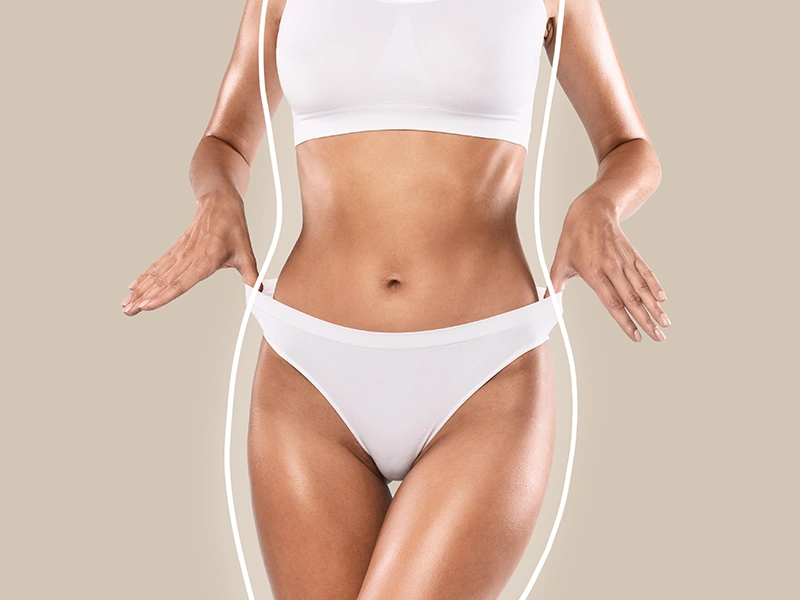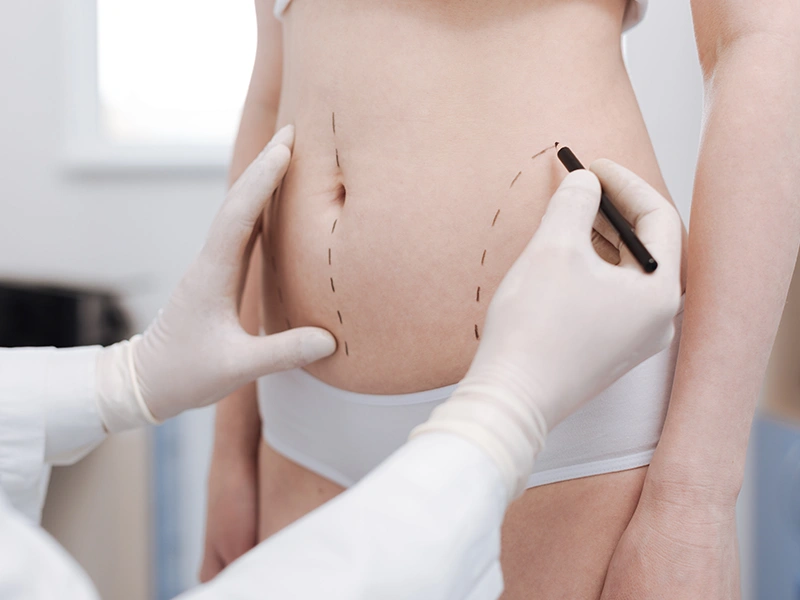Aesthetic surgery offers numerous options for individuals to feel better about themselves and shape their appearance as desired in the modern world. Procedures such as labiaplasty and vaginal tightening allow women to improve the aesthetics of their genital region, while abdominoplasty (tummy tuck) tightens and flattens the midsection. Techniques like six-pack sculpting, arm lifts, and various types of liposuction, including arm liposuction and Vaser liposuction, sculpt the body to achieve desired contours. The Brazilian Butt Lift (BBL) enhances and reshapes the buttock area. For men, gynecomastia surgery addresses enlarged breast tissue. Treatments for hyperhidrosis offer relief from excessive sweating. Inner thigh lifts and otoplasty (ear surgery) are additional options for refining one's silhouette and facial features, respectively. Advances such as J-plasma technology further refine and tighten the skin. The mommy makeover combines several procedures to restore a woman's body post-pregnancy, showcasing the comprehensive and transformative potential of body aesthetics in enhancing self-confidence and well-being.
Body aesthetic surgery encompasses a broad spectrum of procedures designed to enhance, reshape, and rejuvenate the body to align with individual beauty ideals and boost self-confidence. From labiaplasty and vaginal tightening that address the genital area, to abdominoplasty (tummy tuck) and six-pack sculpting for a more defined abdomen; arm lifts and various liposuction techniques, including arm and Vaser liposuction, aim to refine body contours. The Brazilian Butt Lift enhances buttock shape, while gynecomastia surgery addresses male breast enlargement. Hyperhidrosis treatments offer solutions for excessive sweating, and inner thigh lifts, along with otoplasty, cater to more specific aesthetic desires. Advanced techniques like J-plasma enhance skin tightening, and the comprehensive mommy makeover tackles post-pregnancy body changes, showcasing the diverse options available for personal transformation and well-being through body aesthetics.


Body aesthetic refers to the practices, treatments, and procedures aimed at enhancing, altering, or rejuvenating one's physical appearance to align with personal or societal beauty standards. It encompasses a wide range of surgical and non-surgical interventions designed to improve the shape, size, and overall appearance of various parts of the body. These aesthetic procedures can target nearly any area of the body, including the face, breasts, abdomen, buttocks, legs, and skin.
The goal of body aesthetic treatments is not only to address specific physical concerns or imperfections but also to boost the individual's confidence and self-esteem by aligning their external appearance with their internal perception of beauty. Surgical procedures like liposuction, breast augmentation, abdominoplasty (tummy tuck), and facelifts are popular options for making more significant and permanent changes. Non-surgical options may include injectables (like Botox and dermal fillers), laser treatments, and skin tightening procedures that offer less invasive solutions with shorter recovery times.
Body aesthetic practices are highly personalized, taking into account the individual's unique body shape, goals, and health considerations. The choice to pursue aesthetic treatments is driven by a variety of factors, including the desire for rejuvenation, correcting asymmetries or deformities, or simply enhancing one's natural features. As the field of cosmetic and aesthetic surgery evolves, new technologies and techniques continue to expand the possibilities for individuals seeking to improve their appearance and wellbeing.

Good candidates for body aesthetic procedures are those who are in overall good health, have realistic expectations about the outcomes, and are non-smokers or willing to quit, as smoking can impair healing. They should be at or near their ideal weight, with specific concerns that cosmetic surgery can address, such as excess skin after significant weight loss, stubborn fat areas, or sagging skin that diet and exercise cannot improve. Ideal candidates also possess good skin elasticity, are psychologically stable, fully understand the risks involved, and are prepared to commit to the necessary post-operative care. Moreover, they should be financially ready for the costs associated with their procedure, including aftercare and potential time off work for recovery. Consulting with a qualified plastic surgeon is essential to discuss goals, options, and determine suitability for the desired aesthetic procedures, ensuring that individuals have a clear understanding of what to expect for the best possible outcomes.
The cost of body aesthetic operations varies significantly based on the procedure type, geographic location, surgeon's expertise, and case complexity. Less invasive treatments may cost a few hundred dollars, while extensive surgeries like abdominoplasty or breast augmentation can range from $3,000 to over $10,000. Geographic location influences prices due to varying costs of living and surgeon demand, with costs generally higher in urban areas. Surgeons with extensive experience and strong reputations often charge more, reflecting their expertise. The complexity of the individual's case can also affect the price, as more involved procedures require more time and resources. Additionally, the overall cost includes various fees such as those for the surgical facility, anesthesia, medical tests, post-surgery garments, and follow-up appointments. Since most cosmetic procedures are elective, they're typically not covered by insurance, necessitating out-of-pocket payment or financing options. It's crucial for potential patients to discuss all costs with their surgeon during the consultation to fully understand the financial commitment involved.


Body aesthetic procedures offer a myriad of benefits, significantly enhancing one's physical appearance and aligning it with personal or societal beauty standards, which in turn boosts self-confidence and self-esteem. These procedures not only improve aesthetic appeal but also address physical discomforts, such as back and neck pain from oversized breasts or the inconvenience of excess skin. Furthermore, the positive changes often motivate individuals to adopt healthier lifestyles to maintain their results. Certain surgeries can correct physical impairments, contributing to improved functionality and quality of life. Anti-aging treatments help individuals achieve a more youthful and revitalized look, providing psychological benefits by alleviating anxiety and depression linked to body image issues. With the advancement of medical technologies, body aesthetic treatments have become highly customizable, offering tailored solutions that cater to individual needs and goals, ensuring natural-looking and satisfying outcomes. It's crucial, however, for individuals to maintain realistic expectations and select qualified professionals to maximize the safety and effectiveness of their chosen procedures.
Embarking on a body aesthetic procedure journey begins with a consultation, where you discuss goals, options, and concerns with a qualified surgeon, setting the stage for realistic expectations. Preparation involves lifestyle adjustments and pre-operative instructions to ensure optimal outcomes. The procedures themselves vary in complexity, from minimally invasive treatments with little downtime to more extensive surgeries requiring hospital stays and general anesthesia. Recovery periods differ significantly, with immediate post-procedure effects often masked by swelling or bruising, and final results taking months to fully materialize, necessitating patience. Follow-up care is crucial for monitoring the healing process, and the emotional impact during recovery can range from excitement to impatience, highlighting the importance of support networks. Long-term success often requires lifestyle changes, such as a healthy diet and exercise, to maintain results, emphasizing the need for a commitment to post-procedure care and a stable weight. Understanding these steps and maintaining open communication with your healthcare provider are key to navigating the body aesthetic process successfully, ensuring safety and satisfaction with the outcome.

